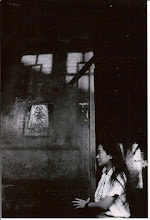Above the Abyss: The Birth of the Soul and the Divine Gaze
By Ruòchén (July 2025)
At the bottom of the canvas, a deep, bottomless pit opens like a cosmic womb; above it, a humanoid infant figure leans forward in silent inquiry, as if the moment of the soul’s birth has been frozen in eternity.
This painting is profoundly revelatory within a theological framework. The overhead perspective disrupts linear spatiality and instead summons the viewer into a vertical structure of hierophany—a sacred manifestation—where an upper existence peers into the void below. It evokes the moment a soul descends from transcendence into immanence.
I. Fall and Creation: The Abyss in Christian Imagination
In Christian language, the abyss often signifies chaos, fallenness, and trial—but also the state preceding creation. Genesis 1:2 declares: “Now the earth was formless and empty, darkness was over the surface of the deep, and the Spirit of God was hovering over the waters.” This “deep” (tehom) is both terrifying and generative—the origin point of divine order.
The ambiguous chasm depicted—a vortex neither wholly well nor void—resembles that primordial chaos awaiting the divine Word. The figure bending forward responds with a spiritual will. It may symbolize free will in theology: to approach the void is an act of voluntary descent, a recognition of one’s finitude and creatureliness. Alternatively, it may allude to Christ’s kenosis—“he emptied himself, taking the form of a servant” (Philippians 2:7)—a reenactment of the Incarnation.
II. Wounding and Rebirth: Psychotheology and the Soul’s Archetype
From a psychotheological perspective, the infantile figure suggests the vulnerability of a newly born soul. In Jungian terms, the archetype of the Self often appears in childlike form—representing the original wholeness of being and the gateway to the archetype of divinity.
Yet this gateway takes the shape of an abyss, recalling the inscription at the entrance to Dante’s Inferno: “Abandon all hope, ye who enter here.” Still, as the mystical tradition reminds us, the fall is never the end—but the moment God draws near.
The soul cannot begin its journey from a state of wholeness. It must first descend into nothingness, feel the estrangement from God, and only then begin its ascent. This painting captures the threshold of that “dark night of the soul”—not the end of darkness, but the womb of light.
III. Composition and the Divine Gaze: A Question in the Post-Religious Age
The upper half of the painting is engulfed in dense darkness, symbolizing the wholly Other—the unspeakable mystery of God. This unfigured darkness resists representation, echoing Karl Barth’s assertion: “God’s silence is itself a form of revelation.”
No clear image of God appears, yet the childlike body itself becomes a veiled icon—an imago Dei. In this post-iconic, post-narrative era, art no longer speaks for God. Rather, it evokes the possibility of faith by attempting to see the divine. The viewer watches the child; the child gazes into the abyss—but perhaps the true gaze is that which returns from the abyss itself. It is God, watching us.
Conclusion: Divinity Is Born in Unease
This painting is a theological crystallization—a moment suspended between creation and fall, birth and death, belief and doubt. Though silent, it carries a deep summons:
Are we willing, standing above the abyss, to reach into the unnamed darkness?
For it may be precisely there—at the edge, at the rupture of existence—that God still waits.


